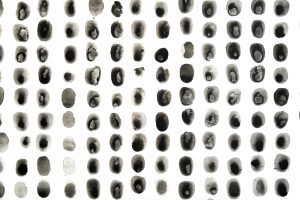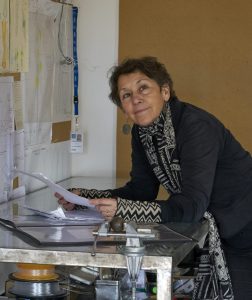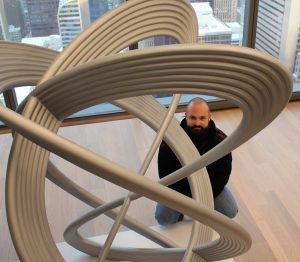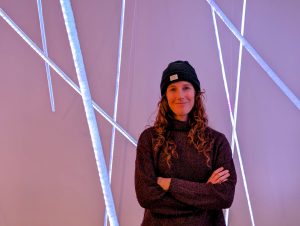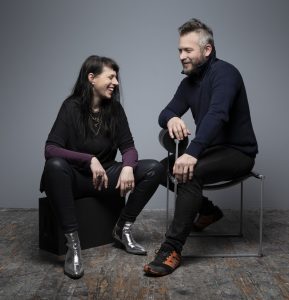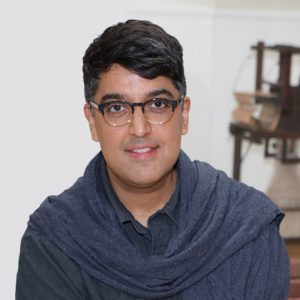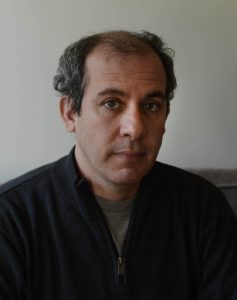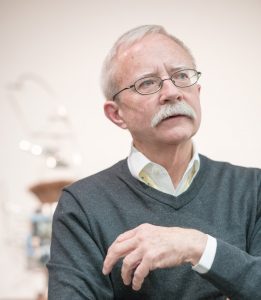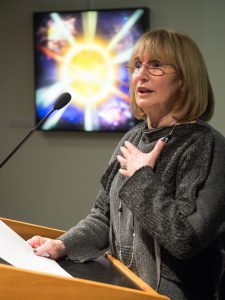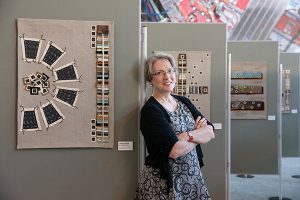Jelena Berenc 2025
“Both Art and Science question the world; they bring new thoughts to the world, and re-contextualize preconceived ideas and views. This position makes an ideal opportunity for asking, confirming, developing, and understanding questions.”
Read more about Jelena Berenc in the Fermilab News announcement here.
Past Guest Artists
Agnes Chavez 2024
New Mexico-based artist Agnes Chavez will work with Fermilab scientists to explore new ways to use data visualization, light, sound and space to communicate the importance and relevance of science, in particular research on particles called neutrinos.
An interdisciplinary new media artist and educator, her work integrates art, science and technology as tools to inspire artistic, scientific and humanistic literacy and to raise awareness to humanitarian and ecological issues. She explores data visualization, light, sound and space to create immersive and educational installations that seek balance between mind and matter, science and art, nature and technology.
Read more about Agnes Chavez in the Fermilab News announcement here.
Ricardo Mondragon 2023
My artistic practice consists of creating art that reflects the deep harmonic design of the universe. A world that may seem detached and far from our everyday social experience is revealed with coherent fashion and high-quality materials. Playing with the boundaries between the visual and musical is an old game. From Pythagoras to Kandinsky, harmonies have been explored.
Ricardo currently has artwork displayed in the Fermilab Art Gallery.
Mare Hirsch 2021
Through my art and research, I seek to expand conventional methods of creative practice by developing and using artist-centric technologies. To do so, I draw on methods and tools from other domains, such as computer science and engineering, to reimagine technology’s role in art in a way that is inclusive to a broad diversity of media. Hirsch created an art installation “Precession”, a data-driven installation that explores the intangible scales of time and space inherent to the Muon g-2 experiment at Fermilab.
Chris Klapper & Patrick Gallagher 2020
We often have described the act of creating art as a poetic expression of its subject material, a kind of translation. In this, our main goal from the very start was to create an expression that could draw direct relationships between this stunningly complex subject and connect it to the larger realm of the human experience. A way to show that within the densely intricate mathematics and abstract theories behind the physics of our invisible universe, there was a symmetry and sameness shared with the world and experiences on a human scale.
Isaac Facio 2019
Facio says that collaborations between art and science are important because of the commonalities in the questions pursued by their respective practitioners. He says artists and physicists can influence one another’s work by offering complementary perspectives on these questions.
“There is something beautiful about the uninhibited exploration that takes place in an art studio and the methodical and intentional exploration that a science lab has,” Facio says. “We have common interests and different approaches.”
Adam Nadel 2018
During my artistic investigation at Fermilab I employed traditional film cameras, historical documents, scientific data, and a particle accelerator. I created works on traditional silver gelatin photographic paper via negative and direct exposure to an electron beam, watercolor paper, wood, and music in transcription form. These works explore those who work at the lab and the subatomic world they are directly or indirectly engaged. The goal is to bridge art and science in celebrating one of humanity’s most extraordinary and important endeavors.
Jim Jenkins 2017
My intent is to be open to the rich and mind-expanding possibilities of examining the history of the lab, it’s unique setting, personalities past and present and experimental future. My hope is that unexpected cerebral, visual and auditory inputs will result in experimental explorations into intersecting nodal ambiguities. Perhaps demonstratable consiliences will result. It may also be a way for me to keep my mind and hands busy while passing the time dreaming about the dream I may be dreaming.
Jim Jenkins currently has artwork displayed in the Fermilab Art Gallery.
Ellen Sandor 2016
Fermilab’s 2016 artist-in-residence Ellen Sandor and (art)n spent months talking with Fermilab scientists and learning about the ways they study subatomic particles called neutrinos. Inspired by the things she saw and heard, she created a series of new works in several different media, works that visualize the invisible science of particle physics.
Sandor and (art)n are perhaps best known as the inventors of a new artistic medium called PHSColograms. These three-dimensional pieces combine photography, holography, sculpture and computer graphics to create immersive experiences, and Sandor and her team have used this technique to visualize particle interactions.
Lindsay Olson 2015
My artistic practice grows out of an intense curiosity about the ways our society is supported by science and technology. I use my training to create art about the hidden realities of our world. I worked with scientists, members of the operations crew and numerous staff throughout the lab to learn the basics of high-energy physics. Creating work inspired by dedicated Fermilab scientists opened a new way for me to view reality and enriched my studio practice.




